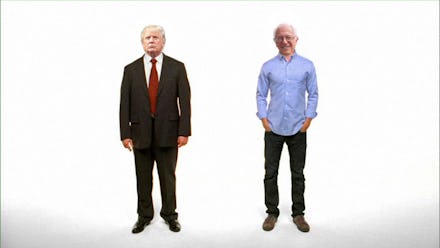Mac Users Love Bernie Sanders, While Trump Fans Are Most Likely to Have an AOL Email

What you buy, where you live, what kind of drink you order — all of these little details can betray your political identity. But your choice of technology, your phone, your computer and even your email address can be just as telling when it comes to your vote.
Advertising analyst Daniel Prager, a senior associate at SapientNitro, put together a demographic breakdown of each candidate's millions-strong Facebook audience, including their technology habits. Here's what he found.
A sample of the findings
Bernie Sanders fans are far more likely to use Macs than any other candidate's audience, while those who stan for Donald Trump love their PCs more than any other group.
The same dichotomy holds true for email: Sanders supporters are the most likely to use Gmail, while Trump supporters are more likely to have an AOL account.
In terms of computer use, the demographic correlation is clear. Apple users are stereotypically young and urban, and Apple targets college kids and people in artistic fields like design and photography as the ideal purchasers of their high-end laptops and desktops.
But that doesn't mean Democrats are all iPhone devotees. Those interested in Republican candidates Marco Rubio and Jeb Bush have much higher rates of iPhone use than those interested in Hillary Clinton and Bernie Sanders, who lead in Android use by a large margin.
"It is surprising that Rubio and Jeb supporters have iPhones, but those supporters typically have higher net worths as well," Prager suggested to Mic. "So that might be an affluence story."
As for the Sanders camp's love of Gmail and Trump fans' loyalty to AOL, studies show that up to 72% of Gmail users are under the age of 34, where those with AOL email accounts are typically older and skew married and suburban. Inexplicably, millions of AOL subscribers are still paying AOL a monthly fee for internet access after signing up a decade ago — even though they don't need to.
Where is this data from? Prager pulled the info by measuring the size of each pool of interested Facebook users for each candidate — as low as 2.2 million in the case of Bush, and as many as 8.7 million in the case of Trump — and narrowed the inquiry for each demographic designation. (Anyone trying to buy an ad from Facebook has access to this information.) Prager spent roughly 10 hours entering data into Excel from Facebook's Ad Planner tool, he told Mic.
It's more of a broad cross-section than a scientific poll — Facebook's audience naturally skews younger than the electorate overall. The people Facebook includes in this data may not be declared supporters with Vote Trump signs on their lawns. Instead, they're placed into each camp based on liking candidates' Facebook pages, clicking through to articles about them and sharing content in a way that supports a candidate. It's possible some people end up in multiple candidates' pools.